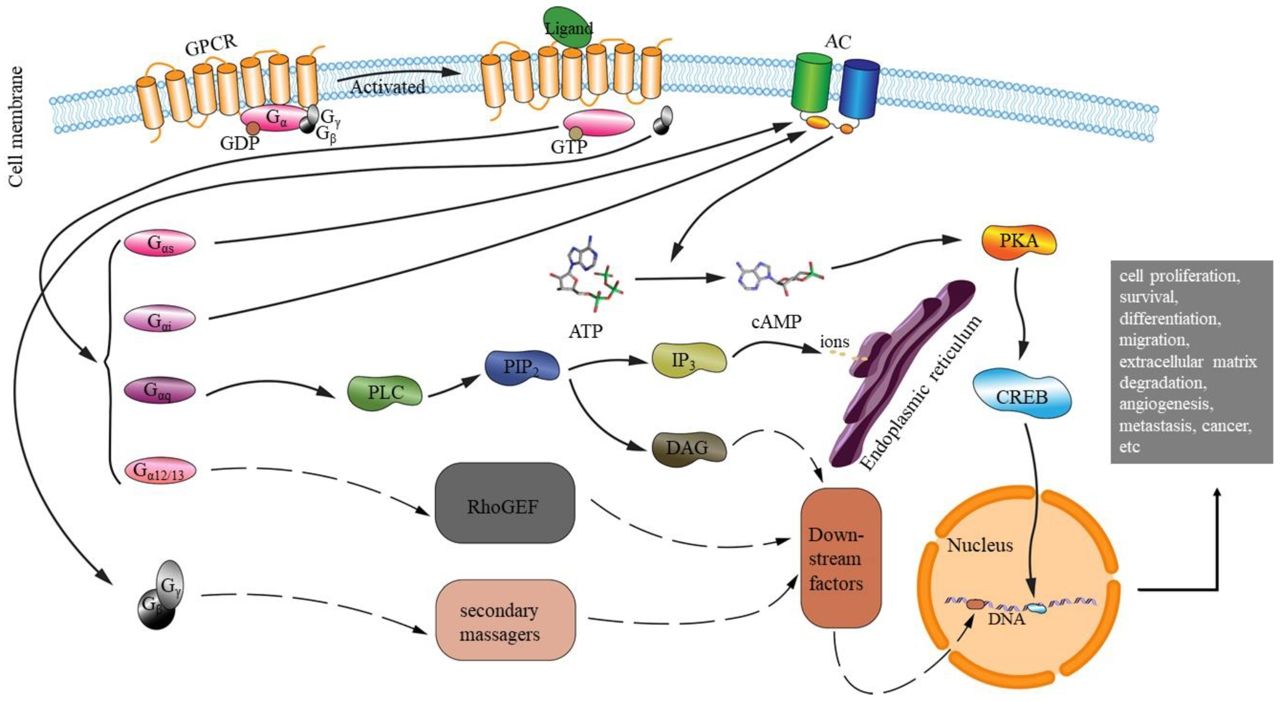Hi-Affi™ GPCR Stable Cell Lines for Antibody Function Study
G protein-coupled receptors (GPCRs) belong to a superfamily of cell surface signaling proteins that have a pivotal role in many physiological functions and in multiple diseases, including the development of cancer and cancer metastasis. Drugs especially antibodies targeting GPCRs are hotspots of current research. Nowadays, continuous efforts are underway to develop new technologies to evaluate functional profiles of anti-GPCR antibodies. Creative Biolabs now launches a broad range of Hi-Affi™ GPCR engineered cell lines as a powerful tool for antibody function study.
Introduction of GPCRs
G-protein-coupled receptors (GPCR), known as 7 transmembrane receptors, are the largest family of cell surface receptors and account for approximately 4% of the protein-coding human genome. Ligand binding to GPCRs results in conformational changes, promoting G-protein coupling, which is the initiation of signal transduction pathways.
Upon activation, GPCRs can recruit heterotrimeric G proteins composed of G-α, G-β, and G-γ subunits. This triggers an allosteric change in G-α, causing GDP to leave and be replaced by GTP. GTP activates G-α, which will then be dissociated from G-β-γ dimer. Subsequently, activated G-α can diffuse along the membrane surface to activate (and sometimes inhibit) target proteins, often enzymes that generate second messengers such as cyclic AMP, inositol triphosphate (IP3) and Ca2+.
 Fig.1 A graphical illustration of the locations of GPCR regulatory pathways.1, 2
Fig.1 A graphical illustration of the locations of GPCR regulatory pathways.1, 2
GPCR signaling is a complicated, highly-regulated network, involving a wide spectrum of physiological events. In presence of continuous agonist stimulation, GPCRs are phosphorylated by specific GPCR kinases (GRKs), which will eventually terminate G protein signaling and lead to a coordinated process of receptor desensitization, inactivation, and internalization.
Design Principle of Hi-Affi™ GPCR Cell Lines
Inspired by two signaling pathways involved in GPCR signaling pathways, Creative Biolabs has introduced an innovative anti-GPCR antibody function screening system in virtue of different fluorescent biosensor linked with the activity of 3 secondary messengers (cAMP, DAG, Ca2+). Once the particular signal pathway is activated, engineered biosensor on plasma membrane will quickly translocate into the cytosol, thus elicit obvious fluorescence changes. In contrast to conventional reporter gene assay, this strategy provides a rapid, convenient and precise alternative for function profiling of GPCR-targeting agents.
Featured Advantages of Hi-Affi™ GPCR Cell Lines
- Time-, cost-saving
- Straightforward operations, with no special requirements for reagents or equipment
- Suitable for high-throughput screening
- Amendable to multiplicity screening to isolate potentially biased ligands in a single assay
- No modifications/labeling of GPCRs or pathway components, maximally preserving the native signaling events
List of GPCR Cell Lines
Creative Biolabs has integrated a wide variety of GPCR stable cell lines with engineered biosensors. Of note, we also provide multiplexing cell lines co-expressing 2 biosensors in different colors, e.g. cAMP and Ca2+, cAMP and DAG, DAG and Ca2+, constituting an excellent tool for multiplicity screening/assays. By simultaneously measuring two pathways in a single assay, this system can be particularly useful to identify GPCR biased ligands, which activate only one GPCR cellular pathways and greatly enhance the chances to find potentially ideal compounds.
Currently available Hi-Affi™ GPCR biosensor cell lines:
| Ca2+-activated | cAMP-activated | DAG-activated |
| BB2 (Bombesin receptor 2) | ADRB2 | ADRA1A |
| CCK1 | AVPR2 | ADRA1B |
| CCK2 | CRHR2 (CRF2) | CCKAR |
| M5 (Muscarinic 5) | GLP1R | Muscarinic 5 |
| NK1 (TACR1) | GLP2R | |
| NK3 (TACR3) | LHCGR | |
| M4 (Muscarinic 4) | ||
| MCR3 (Melanocortin receptor 3) | ||
| PAC1R | ||
| VIPR1 | ||
| VIPR2 |
Dedicated in antibody drug development for decades, scientists in Creative Biolabs are happy to leverage our leading-edge technologies & resources and extensive experience to assist our clients. Our broad collection of human GPCR cell lines give customers complete flexibility to choose the ideal one that satisfies every particular need. Please contact us for more information and a detailed quote.
References
- Liu, Nannan, et al. "G-protein coupled receptors (GPCRs): signaling pathways, characterization, and functions in insect physiology and toxicology." International Journal of Molecular Sciences 22.10 (2021): 5260.
- under Open Access License CC BY 4.0, without modification.
For Research Use Only.
